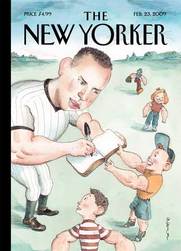Emdashes—Modern Times Between the Lines
The Basics:
About Emdashes | Email us
Ask the Librarians
Best of Emdashes: Hit Parade
A Web Comic: The Wavy Rule
Features & Columns:
Headline Shooter
On the Spot
Looked Into
Sempé Fi: Cover Art
Sempé Fi (On Covers): Strikeout Leader
Filed under: Sempé Fi Tagged: Alex Rodriguez, art, Barry Blitt, baseball, covers, illustration, Pollux, sports

Pollux writes:
“I know I can make a difference on this issue,” baseball player Alex Rodriguez, called A-Rod by some (and A-Fraud by others), has recently remarked in regards to educating the young on the dangers of steroid use. Blitt’s February 23, 2009 New Yorker cover depicts just exactly what difference Rodriguez will make on today’s youth: bigger biceps.
Blitt’s cartoon takes place in an idyllic, as-American-as-apple-pie parkland: Rodriguez blithely and humbly signs young Timmy’s autograph book as other local kids enthusiastically gather around their hero. Rodriguez’s arms are as large as coiled pythons, and the children have imitated their hero by hopping themselves up on illegal ‘roids.
In response to Blitt’s now infamous Obama cover, the cartoonist has stated that “it seemed to me that depicting the concept would show it as the fear-mongering ridiculousness that it is.” Fair enough, but Blitt’s new cover, which he calls “Off Base,” strikes an ambivalent note. As with the Obama cover, Blitt once again produces an ambiguous message. Is Blitt capturing and satirizing fears regarding Rodriguez’s promise to educate kids on the dangers of steroids? Or is he attacking Rodriguez directly? Blitt’s watercolors and linework haven’t created the monster that the cover itself suggests that Rodriguez may be, but rather a sympathetic, benevolent figure. The drawing inhabits the soft towns of Norman Rockwell rather than the ruthless landscapes of Hogarth and Daumier. Blitt, although immensely talented as an artist, wants it both ways again: he wants to represent fear-mongering ridiculousness without agreeing with this fear-mongering ridiculousness himself.
But that really isn’t possible, and this iffiness has produced a less than successful cover. Whether you care about baseball or not, A-Rod’s cheating and perjury make him a less than attractive figure in an American landscape that already seems to be ravaged more than usual by cheats and liars, from the corked bats and Primobolan in the world of athletics to the corked hedge funds of Madoffian financing, from Bush’s yellowcake uranium claims to Blagojevich’s sleazy influence peddling and pay-to-play schemes. It isn’t the time for fuzzy and hesitant artistic attacks or for pulling punches. Blitt once again has created a cover whose actual target is unclear. Is Rodriguez the actual target of the attack or is the target actually our fears that somehow Rodriguez will push Decadurabolin and Sustanon on unsuspecting children?
Blitt has swung and missed.





Comments
This is an outstanding assessment, Pollux. I agree that it doesn’t seem as thought through as some of Blitt’s other covers — I’ve come to be a fierce defender of the infamous fist-jab cover, on the same grounds that Blitt mentions: in effect, it took the nation two days to realize that the cover is only intelligible in a universe in which Obama is not a terrorist. That is to say, the meaning of the cover is that he is not a terrorist.
As difficult to like and obviously culpable as A-Rod is, I think at this point the only proper attitude towards him is compassion. He’s the most scorned player in the sport (save Bonds), which he has been for several years. Sure, it’s his own doing, but when the NY Post runs “A-HOLE” as its headline, as it did a couple days after the steroids news broke, it’s a sign that maybe people have been piling on. It would have been truly daring if The New Yorker had been the first major outlet to get to that place.
For me, it was a dystopian scenario, deliberately grotesque even in its outward pastel mildness. I took it as being about more than A-Rod—we’ve got a nation of medicated kids and a fantasy about professional athletes that includes none of the drug-scoring, self-injecting moments that Mickey Rourke performs so brilliantly (and nonchalantly) in The Wrestler.
The heroes whose signatures are instant collectibles are often (not always, of course) violent louts whose chemical cocktails and cartoon-masculinity culture can make for an unattractive combination. Blitt’s drawing plays into the myth of racially and sexually neutral, kindly, kid-pleasing public servant that drives generation after generation of kids into professional sports and generation after generation of professional athletes to shock, disgust, and disappoint their fans.
So, I think, the musclebound fans here are just as charmingly naive, sweetly celebratory of the great American game, and naturally pumped as their favorite baseball player—that is to say, not at all.
I feel sorry for him too, Martin. Our expectations regarding athletes are so high that our hopes crash only more dramatically when people like A-Rod are caught cheating. But I don’t think there was ever a rosy time when all athletes were 100% honest. I think if Blitt wanted to do grotesque, he should have gone all the way. There’s two much sitting on the fence, artistically speaking, here.